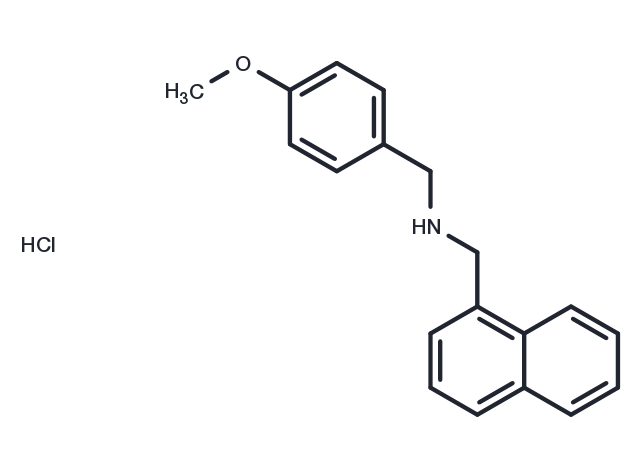Powder: -20°C for 3 years | In solvent: -80°C for 1 year


ML133 hydrochloride (ML133 HCl) is a selective potassium channel inhibitor for Kir2.1 with IC50 of 1.8 μM (pH 7.4) and 290 nM (pH 8.5), has no effect on Kir1.1 and weak activity for Kir4.1 and Kir7.1.

| Pack Size | Availability | Price/USD | Quantity |
|---|---|---|---|
| 5 mg | In stock | $ 43.00 | |
| 10 mg | In stock | $ 61.00 | |
| 25 mg | In stock | $ 108.00 | |
| 50 mg | In stock | $ 173.00 | |
| 100 mg | In stock | $ 288.00 | |
| 200 mg | In stock | $ 373.00 | |
| 500 mg | In stock | $ 629.00 | |
| 1 mL * 10 mM (in DMSO) | In stock | $ 48.00 |


| Description | ML133 hydrochloride (ML133 HCl) is a selective potassium channel inhibitor for Kir2.1 with IC50 of 1.8 μM (pH 7.4) and 290 nM (pH 8.5), has no effect on Kir1.1 and weak activity for Kir4.1 and Kir7.1. |
| Targets&IC50 | KIR2.1 (pH 8.5):290 nM, KIR2.1 (pH 7.4):1.8 μM |
| In vitro | The ratio of total concentration of extracellular ML133 versus intracellular ML133 is 1:0.13 at pH 6.5, 1:9.09 at pH 8.5. ML133 is clean against 3A4 and 2C9 (IC50 >30 μM), displays moderate inhibition of 1A2 (IC50 = 3.3 μM) but proves to be a potent inhibitor of 2D6 (IC50 = 0.13 μM) in CYP450 assay. ML133 is highly protein bound (>99%) in both human and rat and also displays high intrinsic clearance in both species. ML133 (10 μM) is not displaced by K+ influx from the wild-type Kir2.1 in HEK 293 cells. M1 and/or M2 transmembrane domains contain the critical molecular determinant for ML133 inhibition of Kir2.1, especially D172 and I176. [1] |
| Synonyms | ML133 HCl |
| Molecular Weight | 313.82 |
| Formula | C19H19NO·HCl |
| CAS No. | 1222781-70-5 |
Powder: -20°C for 3 years | In solvent: -80°C for 1 year
DMSO: 31.4 mg/mL (100 mM)
You can also refer to dose conversion for different animals. More
bottom
Please see Inhibitor Handling Instructions for more frequently ask questions. Topics include: how to prepare stock solutions, how to store products, and cautions on cell-based assays & animal experiments, etc.
ML133 hydrochloride 1222781-70-5 Membrane transporter/Ion channel Potassium Channel ML133 HCl KcsA Inhibitor inhibit ML 133 Hydrochloride ML-133 Hydrochloride ML 133 ML-133 hydrochloride ML133 ML133 Hydrochloride ML-133 inhibitor
